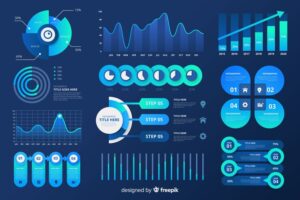In the digital age, data is king, and Google Analytics is the crown jewel. This article delves into the world of Google Analytics and how mastering this tool can help businesses turn data into actionable insights to drive success.
Introduction to Google Analytics
Google Analytics is a web analytics service provided by Google that tracks and reports website traffic, user behavior, and more. It’s a crucial tool for understanding your website’s performance.
The Importance of Data in the Digital Age
Data is at the heart of decision-making in the digital age. It provides valuable insights into user behavior, preferences, and trends.
The Role of Google Analytics for Businesses
Google Analytics empowers businesses by offering a comprehensive view of their online presence. It aids in making informed decisions and improving user experiences.
Setting Up Google Analytics
The initial step in mastering Google Analytics is setting it up. This involves creating an account, property, and installing tracking code on your website.
Navigating the Google Analytics Dashboard
Understanding the dashboard is essential. It provides an overview of your website’s performance, traffic sources, and user demographics.
Understanding Key Metrics
Key metrics like sessions, users, bounce rate, and conversion rate are vital for assessing website performance.
Tracking User Behavior
Google Analytics allows you to track user behavior, including pages viewed, time spent on the site, and user flow.
Conversions and Goals
Setting up goals in Google Analytics is crucial for measuring specific actions users take on your website, such as making a purchase or signing up for a newsletter.
Custom Reports and Dashboards
Tailor reports and dashboards to focus on the data that matters most to your business. Customization enhances efficiency and decision-making.
Advanced Analytics Features
Explore advanced features like e-commerce tracking, event tracking, and enhanced e-commerce for in-depth insights.
Turning Data into Insights
Data is valuable only when it’s transformed into actionable insights. Businesses must learn to interpret data and draw conclusions.
Actionable Strategies for Clients
Using the insights gained from Google Analytics, businesses can develop actionable strategies to improve their online presence, content, and marketing efforts.
Case Studies of Successful Analytics Implementation
Real-world examples of businesses that successfully implemented Google Analytics and achieved remarkable results.
Overcoming Common Challenges
Challenges like data accuracy, tracking issues, and data overload can be overcome with best practices and troubleshooting.
Conclusion
In conclusion, mastering Google Analytics is essential for turning data into actionable insights that drive success. Businesses can use this tool to enhance their online strategies, improve user experiences, and achieve their goals.
FAQ
What is the role of Google Analytics in online business?
Google Analytics provides valuable data and insights about website performance, user behavior, and more. It helps businesses make informed decisions and improve their online strategies.
How can businesses track user behavior using Google Analytics?
Google Analytics tracks user behavior by monitoring metrics like pages viewed, session duration, and user flow, providing a comprehensive view of how users interact with a website.
What are some common challenges when using Google Analytics, and how can they be overcome?
Common challenges include data accuracy, tracking issues, and data overload. These challenges can be addressed through best practices, regular maintenance, and troubleshooting.
What are some key metrics in Google Analytics?
Key metrics include sessions, users, bounce rate, conversion rate, and more. These metrics help businesses assess their website’s performance and user engagement.
How can businesses benefit from Google Analytics in their decision-making processes?
Google Analytics provides valuable insights that inform decision-making processes. It helps businesses understand user preferences, trends, and areas for improvement, ultimately leading to more effective strategies.



